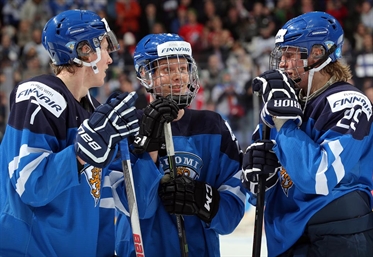The magic of 6-5
The magic of 6-5
Flying Finns tap into history with iconic score

 HELSINKI, FINLAND - JANUARY 2: Finland's Niko Mikkola #7, Olli Juolevi #4 and Patrik Laine #29 are all smiles after a 6-5 quarterfinal round win over Canada at the 2016 IIHF World Junior Championship. (Photo by Andre Ringuette/HHOF-IIHF Images)
HELSINKI, FINLAND - JANUARY 2: Finland's Niko Mikkola #7, Olli Juolevi #4 and Patrik Laine #29 are all smiles after a 6-5 quarterfinal round win over Canada at the 2016 IIHF World Junior Championship. (Photo by Andre Ringuette/HHOF-IIHF Images)
Legendary stars Teemu Selanne and Saku Koivu were on hand and cheering for Saturday’s result. But they were horrified participants in that other game on 7 May 2003.
The host Finns led Sweden 5-1 in the IIHF World Championship quarter-final. But coach Hannu Aravirta’s team crumbled as Tre Kronor roared back for a 6-5 win on P-J Axelsson’s third-period goal. The next day, you didn’t need to speak Finnish to understand the word that was on every Finn’s lips: “Katastrofi.”
So if Jesse Puljujarvi, Patrik Laine and company can parlay their quarter-final victory into gold, “6-5” might truly take on a new, more positive connotation in Finland.
Asked if his team can continue to succeed with this 1980s-style hockey, Finnish captain Mikko Rantanen said: “Hopefully! It’s entertaining for the fans, absolutely. I think we can defend better. Our penalty-killing can be better. We let too many goals in, I think. Maybe we have the worst PK in the tournament? [They are now seventh at 63.1 percent.] But as long as we take wins, we have to be happy.”
That sounds like the attitude the Edmonton Oilers took during their 1980’s Stanley Cup dynasty, with Finnish great Jari Kurri firing bullets on right wing with Wayne Gretzky, and Grant Fuhr striving to make one more save than the other goalie.
A 6-5 score has graced many of international hockey’s greatest games. Traditionally, it’s resonated strongly with Canadians.
Paul Henderson’s 6-5 goal to defeat the Soviet Union in Game Eight of the 1972 Summit Series remains arguably the most iconic moment in modern Canadian history.
Each game in the classic 1987 Canada Cup final between Canada and the Soviet Union finished 6-5. Alexander Semak beat Fuhr with a beautiful high shot as the Soviets won Game One in overtime. Gretzky still cites his five-assist performance in Game Two as his best outing ever, including setting up Mario Lemieux for the double-OT winner. Of course, “The Great One” famously fed Lemieux on an odd-man rush for the Game Three winner with 1:26 remaining.
As for the World Juniors, many Canadians would cite the 6-5 semi-final thriller over Russia in the 2009 tournament in Ottawa as their all-time favourite game, featuring Jordan Eberle’s dramatic tying goal with 5.4 seconds left.
With that said, 6-5 doesn’t always work out for Canada, as we saw on Saturday.
In 2010, John Carlson’s overtime goal gave the U.S. a 6-5 win over Canada in the gold medal game in Saskatoon. In the 2012 semi-finals in Calgary, Yevgeni Kuznetsov scored a hat trick as Russia won by that score, staving off the host nation’s desperate rally from a 6-1 deficit. And in the 2013 bronze medal game in Ufa, Valeri Nichushkin got the OT winner in Russia’s 6-5 triumph over Canada.
The 2016 Finns are old enough to remember those World Junior tilts as they try to forge their own legends en route to the final. They can even see the humour in winning the way they did against Canada. It’s hardly conventional in an era where the 2014 Olympic gold went to a Canadian team that scored the fewest total goals in history (17) and NHL goals per game are at their lowest (under 2.7) since the 2004-05 work stoppage.
“I think it was so funny,” said Finland’s Olli Juolevi. “Of course, I’m a defenceman and I don’t want to let in that many goals. But both teams have good forwards and they are good at scoring.”
If Finland’s goaltending remains a question mark and the top line simultaneously keeps on producing, there may be another 6-5 score coming up for the host nation.
With five goals and 10 assists, Puljujarvi is leading the World Junior scoring race and averaging a blistering three points per game. If he maintains that pace, he would finish with 21 points, equalling Robert Reichel’s 1990 output with Czechoslovakia, the fourth-highest single-tournament total ever. Only Sweden’s Peter Forsberg (31, 1993) and Markus Naslund (24, 1993) and Finland’s Raimo Helminen (22, 1984) have ever gotten more.
These run-and-gun games might not be part of coach Jukka Jalonen’s grand vision. But as far as entertainment value is concerned?
Let the floodgates open. Let the 6-5 scores roll.
Back to Overview
















































